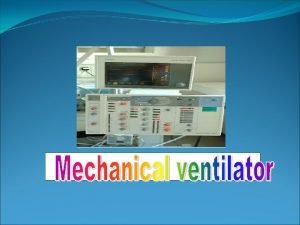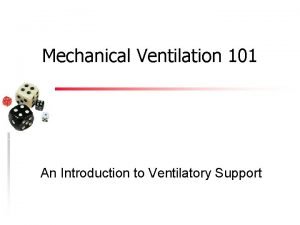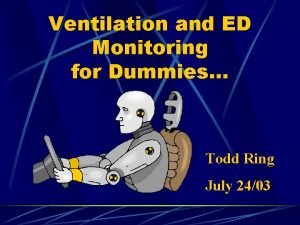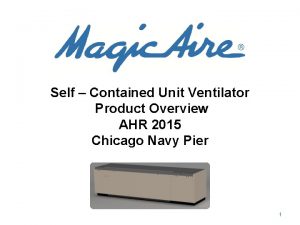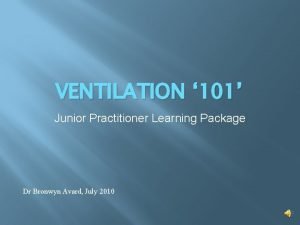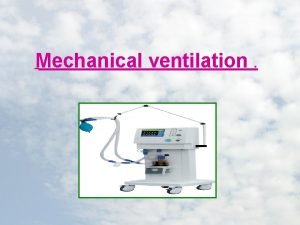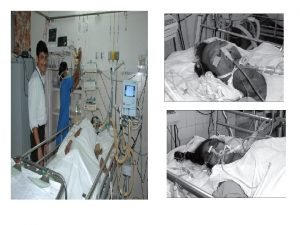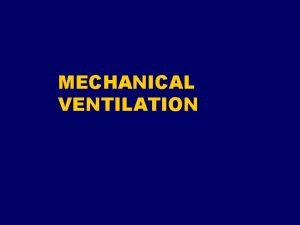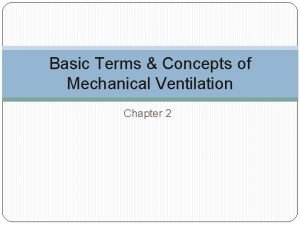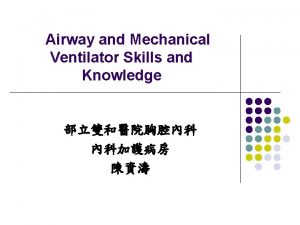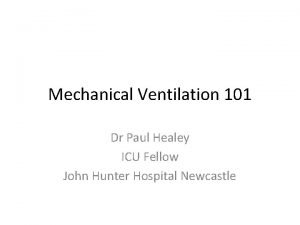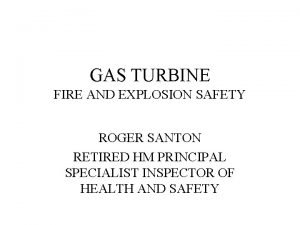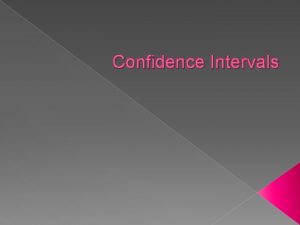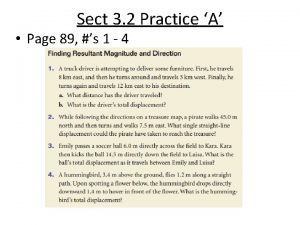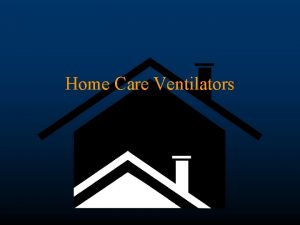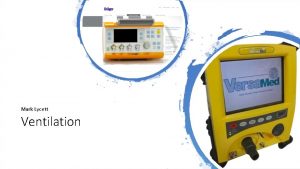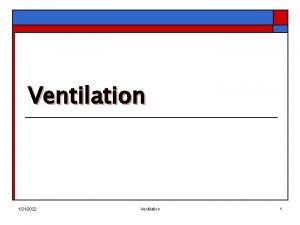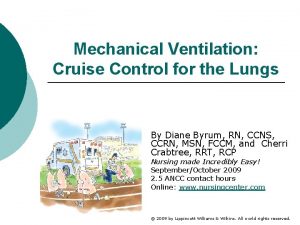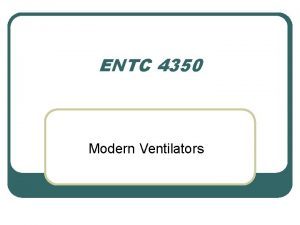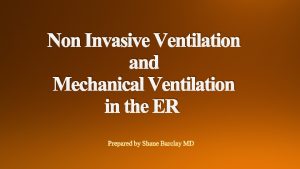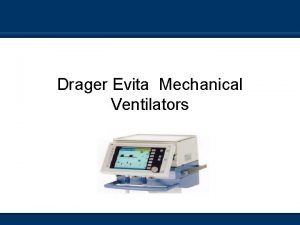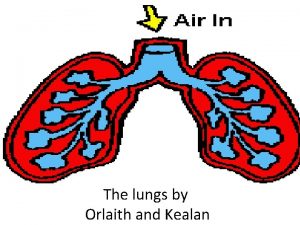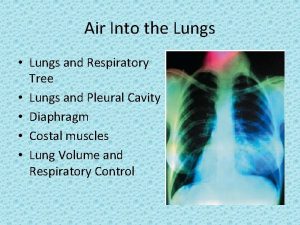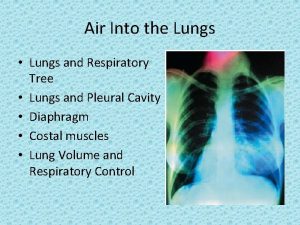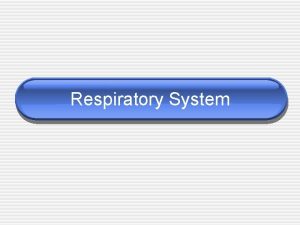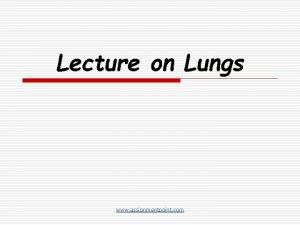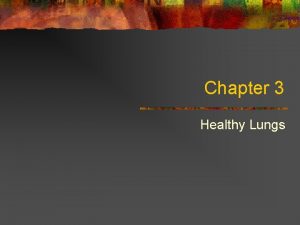Mechanical Ventilation Ventilators deliver gas to the lungs






















- Slides: 22


Mechanical Ventilation Ventilators deliver gas to the lungs using positive pressure at a certain rate. The amount of gas delivered can be limited by time, pressure or volume. The duration can be cycled by time, pressure or flow.

Initiation and maintenance of positive pressure ventilation (PPV) or improve Oxygenation, maintains or improve ventilation and provide respiratory muscle rest.

• Acute Respiratory Failure • Hypoxemia • Neuromuscular Disorders • Pulmonary edema • central nervous system Disorders • Over Sedation • reduce ICP • Aspiration • ARDS • Pulmonary embolism • Left ventricular failure.

Types of Artificial Airways

Basic Concepts in Mechanical Ventilation Flow Pressure Time Volume Respiratory rate FIO 2 PEEP PIP MAP

FLOW. . The amount of air over a specific period of time Constant flow a device which presents a constant of gas past the patient airway.

Pressure. . May be inward atmospheric May be outward (mechanical ventilation)

Time. . Time The time taken to inhale and exhale, including any pause before the next breathing.

Volume. . Volume Tidal volume: the amount of gas in any breath (5 -7 ml/kg of body weight) Minute volume: the total amount of gas breathed over one minutes.

FIO 2. . FIO 2 Fraction of inspired Oxygen % percent of O 2 delivered to the patient Preset on the ventilator and will be mixed with air to be delivered via the ventilator.

PEEP. . PIP. . MAP PEEP: Positive end expiratory pressure, a pressure designed to maintain patent airway PIP: Peak inspiratory pressure The highest pressure attained in breath MAP: Mean airway pressure


Applies negative pressure around the chest wall. No artificial air way is necessary. Inflate the lungs by exerting positive pressure on the airway, similar to a bellows mechanism, forcing the alveoli to expand during inspiration. Requires use of artificial airway.

Mechanical ventilation Modes Negative Pressure Ventilation Positive Pressure Ventilation Pressure Mode Pressure support Ventilation PSV Pressure –controlled Ventilation PCV Volume Mode Control ventilation (CV), Controlled Mandatory Ventilation, CMV Assist Control AC Assisted Mandatory Ventilation AMV Synchronized Intermittent mandatory Ventilation / SIMV Intermittent mandatory ventilation

Volume controlled ventilation Set volume delivered to the patients Volume delivered are preset Fully support patient ventilator requirement

Assist control A /C Inspiratory cycle is activated by the patient Also ventilator cycles at rate predetermine by the operator. Should the pt stop breathing, or breathe so weakly that the ventilator cannot function as an assistor, this mandatory baseline rate will prevent a pnea.

Synchronized intermittent Mandatory ventilation (SIMV) Patient can breath spontaneously through the ventilator circuitry. The pt may initiate the mandatory breath with own inspiratory effort , and the ventilator breath will be synchronized with the pt effort. Provide good ventilatory support +allow respiratory muscle exercise Can be used in weaning

Pressure Support Breath must be initiated from patient Ventilator will then provide gas flow to patients Overcome ETT resistance Provide variable level of support to patients Weaning mode

Airway: Inspiration. Decreased clearance of secretions. Nosocomial or ventilator-acquired pneumonia

Endotracheal tube: -Tube kinked or plugged. -Tracheal stenosis. -lung atelectasis. -Sinusitis. -Otitis media -Laryngeal edema

Mechanical: -hypoventilation with atelectasis -hyperventilation with hypocapnia and respiratory alkalosis -barotraumas , pneumothorax -Alarm "turn off". -Failure of alarms or ventilator. -Inadequate nebulization or humidification. -Overheated inspired air, resulting in hyperthermia
 Mechanical ventilator modes
Mechanical ventilator modes Ventilators 101
Ventilators 101 Transnition
Transnition Magic aire unit ventilators
Magic aire unit ventilators The actual exchange of gases occurs at the site of the *
The actual exchange of gases occurs at the site of the * Ventilation learning package
Ventilation learning package Mode of ventilation
Mode of ventilation Ventilation definition
Ventilation definition Mechanical ventilation indications
Mechanical ventilation indications Basic terms and concepts of mechanical ventilation
Basic terms and concepts of mechanical ventilation Mechanical ventilation firefighting
Mechanical ventilation firefighting Mechanical ventilation indications
Mechanical ventilation indications Iron lung
Iron lung Dope in mechanical ventilation
Dope in mechanical ventilation Gas turbine enclosure ventilation
Gas turbine enclosure ventilation Actual mechanical advantage vs ideal mechanical advantage
Actual mechanical advantage vs ideal mechanical advantage Does ups deliver on saturdays
Does ups deliver on saturdays A catalog sales company promises to deliver
A catalog sales company promises to deliver Cyberextortionist definition
Cyberextortionist definition Discover define develop deliver
Discover define develop deliver A truck driver is attempting to deliver some furniture
A truck driver is attempting to deliver some furniture A truck driver is attempting to deliver some furniture
A truck driver is attempting to deliver some furniture Shona quiz
Shona quiz
